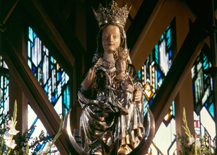
Locality: ESTELLA (31200)
Address: Calle Abárzuza, 1
Zone: The Central Zone
Style: Modern
Centuries of construction: XX
Description
The monumental city of Estella, a key enclave on the Pilgrim’s Way to Santiago, has a modern building amongst its constructions of interest: the basilica of Nuestra Señora del Puy, patron saint of the city.
It is constructed on a hill where, according to legend, an image of the Virgin appeared. First of all a chapel was built, and then a Baroque church and finally this star-shaped basilica recreating the intense light effect that was produced when the carving was discovered.
In the interior a 14th-century Gothic image of the Virgin of the Puy from the 14th century is conserved, together with two images of Christ on the Cross that were made in the 17th century. From the basilica you can enjoy an excellent view over this monumental city on the river Ega.
The basilica
The basilica of Our Lady of the Puy, up on a hill, keeps watch over Estella. It is a modern building of neo-Gothic style designed by the Navarrese architect Victor Eusa. Its construction began in 1929 over an old church, and finished in 1951. A long set of steps allows access from the town below.
It is said that at the place where the present basilica stands, some time around 1085 some shepherds were attracted to the top of the hill by a cluster of stars. Hidden in a cave they found the image of the Virgin Mary.
King Sancho Ramirez ordered the construction of a chapel in her honour, which was replaced in the 17th century by a Baroque church that still conserves some elements of the chapel such as the entrance porch and courtyard in front of it.
Coincidentally, the Apparition of the Virgin occurred before the foundation of the city (in the year 1090), in which year its Fuero (historic rights or privileges enshrined in a Charter) was granted.
This apparent contradiction owes itself to the fact that before this date a spontaneous collection of Franks (merchants) had already settled there and could take advantage of the situation to draw the monarch’s attention to the city and ask him to recognise and protect the populace.
They also tried to attract pilgrims to their shops who otherwise crossed the river Ega two kilometres further south and made their way towards Irache without passing through Estella. This is why they dramatised the miraculous appearance of a Virgin Mary whose name they linked with that of one of the most venerated in all of France: Our Lady of the Puy. Their success was immediate and both objectives were achieved.
The new sanctuary became a major pilgrimage centre where people went in search of miracles. When the Baroque church was demolished in 1929 numerous religious offerings appeared reminding one of the miraculous cures; some offerings were really picturesque, such as the photograph of a youth with a deformed face as a result of a bite from an ass. But the most important miracle occurred in September 1638.
During the battle for the defence of Fuenterrabia, hundreds of people from Estella were sent to fight on the most dangerous part of the front. Worried for their lives, they put their trust in the Virgin, who appeared before them and promised them that all would return safe and sound to the city. The promise was miraculously fulfilled, and the ever-thankful city named her its patron saint. From that moment on she was revered more and more.
In the present basilica, both the ground floor and the roof are star-shaped, an element that is repeated in the decoration and in the furniture. Thanks to this shape and the use of numerous windows, the architect managed to recreate an intense light effect in the interior that alludes to the discovery of the image of the Virgin of the Puy.
The Gothic carving of the Virgin del Puy
The church houses a seated figure of the Virgin of the Puy, patron saint of the locality along with San Andrés (St Andrew). It is in the Gothic style from the end of the 13th century or the early 14th century and is made of polychromed wood and coated in silver. It has a golden crown and a half moon at its feet, both works of the 17th century. The face is emphasised as much in the Mother as the Son for its rounded, serene and smiling demeanour.
The statue of the Virgin of the Puy was kept in a chest until the 18th century, when it was placed on an altarpiece. This chest, of which only the wooden door is conserved, is painted on both sides; on the outside it shows a gold-painted ministry, and inside there is a representation of the Annunciation.
The basilica also contains two interesting images of Christ on the Cross, produced in the 17th century.
The church receives floral offerings on May 25th to celebrate the festivities of the Puy and also in Estella’s main fiesta in August (it starts on the Friday before the first Sunday in August) in honour of Saint Andrew and the Virgin of the Puy.







